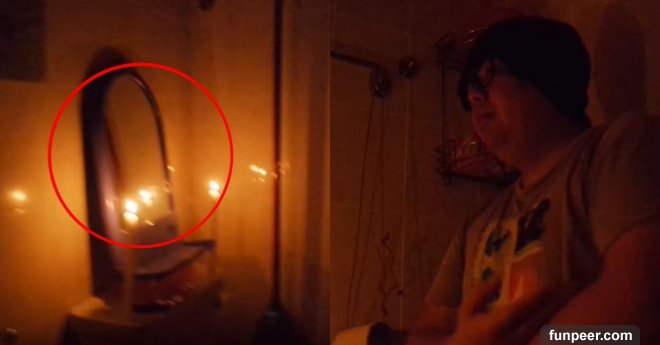[謠言] 把死屍當擺設 [附圖18+]
本帖最後由 aia 於 2009-6-9 03:17 編輯
美國有一個三十二歲的男子Jeff Green 因為喪妻,受不了妻子過世的事實,
決定在喪禮結束後,決定向殯儀佬和當局申請,把妻子放在家中。
他還特別用了六千美元,做了一個玻璃棺材,放在家中客廳當成茶几.妻子就躺在屋中央安睡一般.
有些親友當然驚左佢,但Jeff Green郤當成是家中擺設.以下是英文原文,英文程度好小小的網友可以一看。
(附帶一言:請少去爭論真或者假,但請尊重己離世或當事人)
Origins:
Heartbroken husband has his dead wife"s body preserved and keeps it around the house. In this case, however, the grieving widower has also incorporated his beloved"s corpse into a functional home furnishing!
Jeff Green is a 32 year old American in Arizona, whose wife passed away. Due to the great pain he suffered due to her death, he did something totally out of character for a normal and sane person. He said, "I could no longer take the pain that my wife"s death has caused me, and I brought her back home." This is where Jeff"s story takes a twisted turn. His wife, Lucy, was born with a heart condition that cut her life short at the young age of 29. Lucy"s last words to Jeff were, " We will meet again in heaven."
These words served no consolation to Jeff"s despair. At the funeral, in an act of desperation, Jeff decided that he would not let Lucy leave him.
"I called the cemetery caretaker and explained my feelings. I spoke with the authorities and got special permission to take my wife home with me. They thought it strange, but I was allowed to take her with me. I rather have her at home than seven feet under ground. Lucy had a great sense of humor and I"m sure she would appreciate being my coffee table."
Jeff ordered a special glass casing that eliminates the decomposition of a dead body. "It cost me about $6,000.00, but it was worth it." Some of his friends and relatives, filled with fear, stopped visiting Jeff. His true friends respected his decision and continue visiting him. Some even comment that it is a nice piece of furniture.
This one is just a macabre but silly story. Every state of the U.S. has laws governing who can transport dead bodies and how they can be disposed of, and "The husband would like to take his wife"s corpse home to keep in his coffee table" doesn"t pass muster in any state, no matter how much a "cemetery caretaker" might sympathize with the bereaved, and no matter what influential "authorities" might grant permission. Nor would a glass case (even an airtight one) keep a body entirely free from the effects of post-mortem changes and decomposition. Poor Lucy would had to have been treated with some very advanced embalming and mummification techniques costing many thousands of dollars to preserve her, and even then she still wouldn"t look this good. (The idea of preserving a dead person"s body in a glass case has certainly been around for quite a while, as a 1903 patent demonstrates.)
Readers familiar with aquariums have pointed out "Lucy"s" glass case looks suspiciously like a large fish tank turned onto its side. In particular, they note the side nearest the couch appears to have vertical supports that don"t exist on the side nearest the camera. Large fish tanks are braced this way.
In a nutshell, "Lucy" is more angelfish than angel.
The story has been around for some time. It appears in 1991 collection of silly stories harvested from a United Kingdom tabloid. In that version, the $6,000 cost of building the casket is expressed as £1,500 and the text contains a few Britishisms, including "packets of crisps" (bags of potato chips). Even in this early version, Lucy is said to be in Arizona.
Fakes like the "Lucy" photo appear plausible because most folks are not overly familiar with what happens to dead bodies and thus what is and is not possible in terms of preserving them. A common misconception has it that embalming preserves a body for a very long time, possibly even indefinitely. If truth be told, ordinary funeral home practices maintain the deceased in a state of not-too-terrible decomposition for usually about three days to a week, generally just long enough to get through the funeral without the bereaved being confronted with the smell of ongoing decomposition. Embalmed bodies deteriorate just a little bit more slowly than unembalmed ones, but the end result is pretty much the same -- an embalmed body will go the putrifying way of an untouched one.
Cadavers preserved for medical dissection can be kept viable for about two years, but these are subjected to extraordinary embalming techniques which generally take one to three days to complete. The resultant cadaver does not, however, look lifelike, so one should disabuse oneself of any notion that "Lucy" was subjected to this form of preservation. Likewise, the extraordinary techniques used to preserve Lenin and Peron should be ruled out on their cost basis -- they"d be well beyond the means of any but the super-rich. Lenin, for instance, had to be fully re-embalmed every 18 months and his corpse checked for signs of decomposition and treated with embalming materials twice a week in between.
Odd grammatical errors in the original text and the fact that the filename of the attached picture was "lucymuerte.jpg" might lead one to conclude that this message was originally written in Spanish.
別找我翻譯 ~因為我也看不懂
來源 : 一個不願透露名字朋友寄來的 e-mail![]()
![]()
[圖擷取自網路,如有疑問請私訊]
此消息已被證實為謠言, 欲知更多詳情, 請參閱:
網路追追追/愛妻變咖啡桌...你會為愛這樣做嗎?
http://www.ettoday.com/2007/11/15/515-1565301.htm
美國有一個三十二歲的男子Jeff Green 因為喪妻,受不了妻子過世的事實,
決定在喪禮結束後,決定向殯儀佬和當局申請,把妻子放在家中。
他還特別用了六千美元,做了一個玻璃棺材,放在家中客廳當成茶几.妻子就躺在屋中央安睡一般.
有些親友當然驚左佢,但Jeff Green郤當成是家中擺設.以下是英文原文,英文程度好小小的網友可以一看。
(附帶一言:請少去爭論真或者假,但請尊重己離世或當事人)
Origins:
Heartbroken husband has his dead wife"s body preserved and keeps it around the house. In this case, however, the grieving widower has also incorporated his beloved"s corpse into a functional home furnishing!
Jeff Green is a 32 year old American in Arizona, whose wife passed away. Due to the great pain he suffered due to her death, he did something totally out of character for a normal and sane person. He said, "I could no longer take the pain that my wife"s death has caused me, and I brought her back home." This is where Jeff"s story takes a twisted turn. His wife, Lucy, was born with a heart condition that cut her life short at the young age of 29. Lucy"s last words to Jeff were, " We will meet again in heaven."
These words served no consolation to Jeff"s despair. At the funeral, in an act of desperation, Jeff decided that he would not let Lucy leave him.
"I called the cemetery caretaker and explained my feelings. I spoke with the authorities and got special permission to take my wife home with me. They thought it strange, but I was allowed to take her with me. I rather have her at home than seven feet under ground. Lucy had a great sense of humor and I"m sure she would appreciate being my coffee table."
Jeff ordered a special glass casing that eliminates the decomposition of a dead body. "It cost me about $6,000.00, but it was worth it." Some of his friends and relatives, filled with fear, stopped visiting Jeff. His true friends respected his decision and continue visiting him. Some even comment that it is a nice piece of furniture.
This one is just a macabre but silly story. Every state of the U.S. has laws governing who can transport dead bodies and how they can be disposed of, and "The husband would like to take his wife"s corpse home to keep in his coffee table" doesn"t pass muster in any state, no matter how much a "cemetery caretaker" might sympathize with the bereaved, and no matter what influential "authorities" might grant permission. Nor would a glass case (even an airtight one) keep a body entirely free from the effects of post-mortem changes and decomposition. Poor Lucy would had to have been treated with some very advanced embalming and mummification techniques costing many thousands of dollars to preserve her, and even then she still wouldn"t look this good. (The idea of preserving a dead person"s body in a glass case has certainly been around for quite a while, as a 1903 patent demonstrates.)
Readers familiar with aquariums have pointed out "Lucy"s" glass case looks suspiciously like a large fish tank turned onto its side. In particular, they note the side nearest the couch appears to have vertical supports that don"t exist on the side nearest the camera. Large fish tanks are braced this way.
In a nutshell, "Lucy" is more angelfish than angel.
The story has been around for some time. It appears in 1991 collection of silly stories harvested from a United Kingdom tabloid. In that version, the $6,000 cost of building the casket is expressed as £1,500 and the text contains a few Britishisms, including "packets of crisps" (bags of potato chips). Even in this early version, Lucy is said to be in Arizona.
Fakes like the "Lucy" photo appear plausible because most folks are not overly familiar with what happens to dead bodies and thus what is and is not possible in terms of preserving them. A common misconception has it that embalming preserves a body for a very long time, possibly even indefinitely. If truth be told, ordinary funeral home practices maintain the deceased in a state of not-too-terrible decomposition for usually about three days to a week, generally just long enough to get through the funeral without the bereaved being confronted with the smell of ongoing decomposition. Embalmed bodies deteriorate just a little bit more slowly than unembalmed ones, but the end result is pretty much the same -- an embalmed body will go the putrifying way of an untouched one.
Cadavers preserved for medical dissection can be kept viable for about two years, but these are subjected to extraordinary embalming techniques which generally take one to three days to complete. The resultant cadaver does not, however, look lifelike, so one should disabuse oneself of any notion that "Lucy" was subjected to this form of preservation. Likewise, the extraordinary techniques used to preserve Lenin and Peron should be ruled out on their cost basis -- they"d be well beyond the means of any but the super-rich. Lenin, for instance, had to be fully re-embalmed every 18 months and his corpse checked for signs of decomposition and treated with embalming materials twice a week in between.
Odd grammatical errors in the original text and the fact that the filename of the attached picture was "lucymuerte.jpg" might lead one to conclude that this message was originally written in Spanish.
別找我翻譯 ~因為我也看不懂
來源 : 一個不願透露名字朋友寄來的 e-mail


[圖擷取自網路,如有疑問請私訊]
|
本篇 |
不想錯過? 請追蹤FB專頁! |
| 喜歡這篇嗎?快分享吧! |
相關文章
驚驚驚...驚悚樂園























